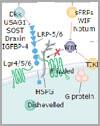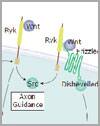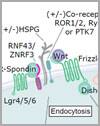Wnt Family

View Wnt Signaling
Pathways:
beta-Catenin-dependent
Wnt Signaling

View Wnt Signaling
Pathways:
beta-Catenin-independent
Wnt/Ca2+ Signaling and
Other Non-canonical Wnt
Signaling Pathways

Wnt Signaling
Pathways:
beta-Catenin-independent
Wnt/PCP Signaling Pathways
The molecular name Wnt is derived from Wingless, the Drosophila melanogaster segment-polarity gene, and Integrase-1, the vertebrate homologue. The Wnt signaling pathway is a highly conserved signal transduction cascade that has a central role in embryonic development, tissue regeneration, and a host of other biological processes. There are three established Wnt signaling pathways: 1) the canonical pathway, involving beta-Catenin, 2) the planar cell polarity (PCP) pathway, and 3) the Wnt-Ca2+ pathway.
Target cell populations respond to secreted Wnt morphogens in a concentration dependent manner, such that the gradient of Wnt concentration determines the resulting gene expression and cellular differentiation. These critical actions make Wnt molecules central to the signal transduction pathways that underlie cell proliferation, survival, and differentiation. The importance of Wnt signaling is underlined by the fact that deregulation of the Wnt pathway results in cancer and other disease conditions. In addition, recent studies have shown that Wnt molecules also play a role in the immune system. Wnt signaling has been shown to regulate T cell development and activation, and dendritic cell maturation.